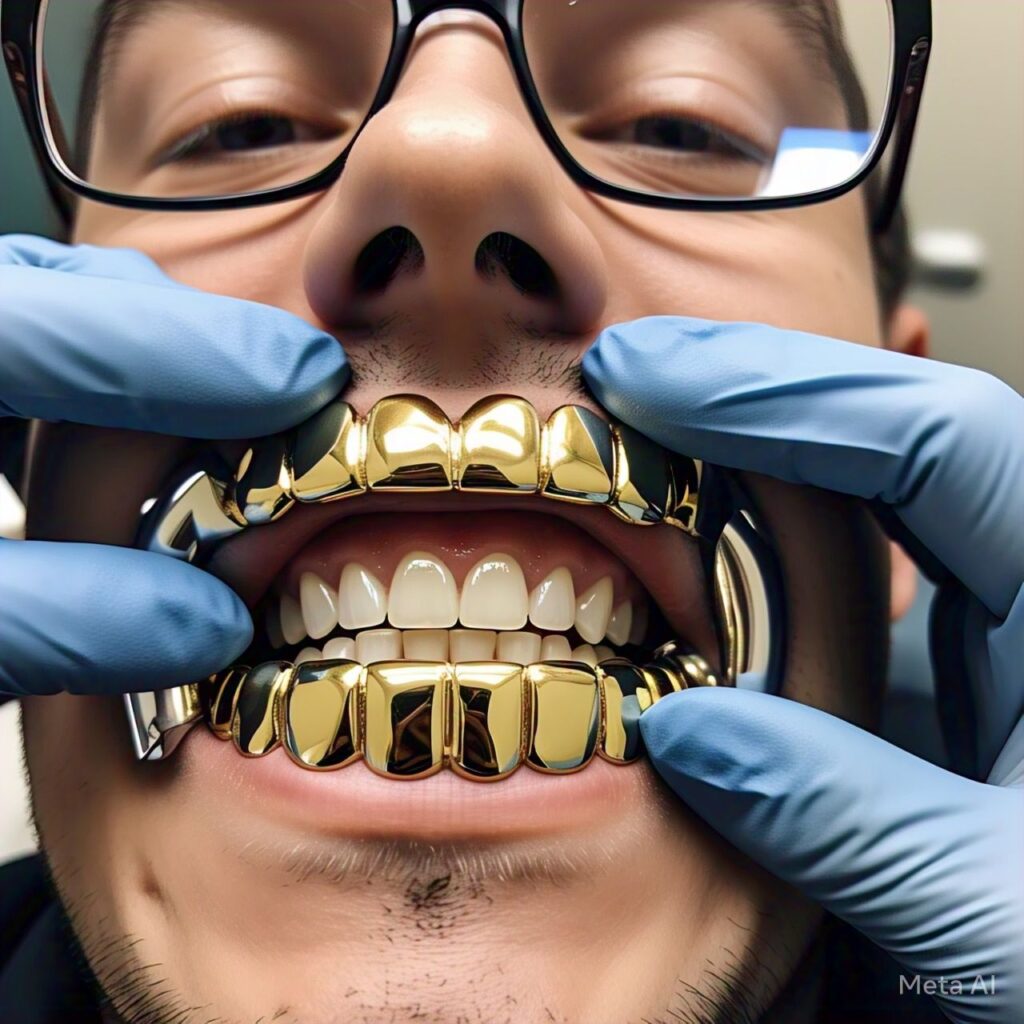A gold onlay tooth has become a popular choice for dental restoration due to its durability, strength, and aesthetic appeal. It offers a practical solution for individuals who need significant repairs to their teeth while maintaining functionality and aesthetics. Over time, dental technology and techniques have made the process of getting a gold onlay tooth easier to do, offering patients a more comfortable and convenient way to restore their smiles.
In this article, we’ll dive into what a gold onlay is, why it’s a favorable choice for many, and how advancements in dental technology have made getting a gold onlay tooth easier to do. We’ll also answer some frequently asked questions to help you make an informed decision about this dental restoration option.
What is a Gold Onlay Tooth?
A gold onlay tooth is a type of dental restoration used to treat teeth that are severely damaged but not completely decayed or lost. Onlays are larger than dental fillings but smaller than crowns, making them an ideal option for restoring teeth that need significant repair, especially in the back molar area. Gold onlays are crafted from a durable gold alloy that provides exceptional strength and longevity.
Gold onlays are custom-made to fit the shape of your tooth perfectly. They are typically used when a cavity or fracture is too large for a simple filling but doesn’t require the full coverage of a crown.
Why Choose a Gold Onlay?
While there are various types of dental onlays, gold onlays have remained a favored option among patients and dentists alike for several reasons:
- Durability: Gold onlays are incredibly strong and can withstand the pressures of chewing, which makes them ideal for molars and premolars that experience heavy stress.
- Longevity: With proper care, a gold onlay can last for many years—often decades—making it a long-term solution for tooth restoration.
- Biocompatibility: Gold is non-reactive with the body, which minimizes the risk of allergic reactions or irritation.
- Aesthetic Appeal: Although gold is not as tooth-colored as other materials, many people appreciate the metallic sheen and the fact that gold can blend well with their natural teeth, especially when used in the back of the mouth.
How Does the Gold Onlay Procedure Work?
The process of getting a gold onlay tooth easier to do has evolved thanks to advancements in dental technology and techniques. While the procedure used to involve several visits, the process is now more efficient and quicker than ever.
Consultation and Evaluation
The first step in the process is a consultation with your dentist, where they will evaluate your dental health and assess whether a gold onlay is the best solution for your needs. The dentist will check the condition of the tooth, determine the extent of decay or damage, and discuss your options with you.
During this visit, your dentist may take X-rays to get a clearer picture of the tooth’s structure and the underlying tissues.
Tooth Preparation
Once the decision is made to proceed with a gold onlay, the dentist will prepare the tooth. This involves removing any decayed or damaged parts of the tooth and shaping the remaining structure so that the onlay can fit securely. The preparation process is typically quick and relatively comfortable for the patient, and the dentist will use local anesthesia to ensure you don’t experience any pain during the procedure.
If you’re getting a gold onlay tooth easier to do, this step has become less invasive due to the development of more precise dental tools, such as laser technology, that minimize discomfort and reduce the need for extensive drilling.
Impressions and Custom Fabrication
Once the tooth is shaped, your dentist will take an impression of the prepared tooth. This is where technology has significantly improved the process. Modern dental practices often use digital scanning to create a 3D image of your tooth, which is then sent to a dental laboratory for onlay creation. This method eliminates the need for traditional molds, making the entire process quicker, cleaner, and more accurate.
Your gold onlay is then custom-made to fit your tooth, ensuring a precise and comfortable fit.
Temporary Filling
While your permanent gold onlay is being fabricated, your dentist will place a temporary filling over the prepared tooth to protect it from any further damage or sensitivity.
Onlay Placement
Once your gold onlay is ready, you’ll return to the dentist’s office for the final placement. The dentist will check the fit and make any necessary adjustments to ensure that the onlay sits comfortably in your mouth. After making sure everything is aligned correctly, the onlay will be securely bonded to the tooth.
The procedure of placing a gold onlay is quick and efficient, and the bonding process is highly effective, providing a strong, durable restoration that will last for years.
Benefits of a Gold Onlay Tooth
There are several reasons why gold onlay tooth easier to do has become a favored choice for patients:
1. Strength and Durability
Gold onlays are highly durable and can last for decades with proper care. Unlike other materials like composite resins, gold can withstand the forces of chewing and biting without cracking or wearing down. This makes them a perfect option for molars, which bear the most stress in the mouth.
2. Precision and Fit
With advancements in digital scanning and 3D imaging, getting a gold onlay tooth has become a highly precise procedure. The digital impressions ensure that your onlay is a perfect match for your tooth, providing a better fit and reducing the chances of discomfort or needing adjustments later on.
3. Long-Term Solution
Gold onlays offer long-term dental solutions. Due to their strength and resilience, they don’t require frequent repairs or replacements, unlike some other materials. This makes them an ideal investment for patients who want a restoration that will last.
4. Minimal Tooth Removal
The process of placing a gold onlay typically requires minimal removal of the natural tooth structure. The dentist only needs to remove decayed or damaged parts of the tooth, which helps preserve as much of the natural tooth as possible.
5. Less Sensitivity
Gold is less prone to expansion and contraction in response to temperature changes, reducing the likelihood of tooth sensitivity when consuming hot or cold foods and beverages.
Why Is It Easier to Get a Gold Onlay Tooth Today?
Advancements in dental materials and technology have made getting a gold onlay tooth easier to do than it was in the past. Several factors contribute to this:
1. Improved Techniques
The development of more advanced tools, such as laser dentistry, has made the process of preparing the tooth quicker and less invasive. This means that patients experience less discomfort and have fewer follow-up visits.
2. Digital Impressions
In the past, traditional impressions involved the use of messy, uncomfortable molds that could be difficult for some patients to tolerate. With digital impressions, patients now enjoy a more comfortable and accurate process, and the impressions are sent directly to the lab, speeding up the creation of the gold onlay.
3. Faster Turnaround Times
With digital technology and more efficient dental labs, the time it takes to create a custom gold onlay has significantly decreased. Many patients can now receive their permanent gold onlay in just one or two visits, making the entire process much faster.
4. Minimally Invasive Options
Modern dental procedures focus on preserving as much of the natural tooth structure as possible. New techniques allow dentists to remove less of the tooth, which means less drilling and a quicker, less invasive procedure.
FAQs About Gold Onlay Teeth
1. Are gold onlays more expensive than other restorations?
Gold onlays can be more expensive than composite fillings or other types of onlays due to the material cost and the precision involved in creating the restoration. However, they are a long-term investment because of their durability, and you may not need to replace them for many years.
2. How long does a gold onlay last?
With proper care, a gold onlay can last 15 to 20 years, sometimes even longer. This longevity is one of the key reasons people opt for gold onlays over other types of dental restorations.
3. Will a gold onlay blend with my natural teeth?
Gold onlays are often used in the back teeth where aesthetics are less of a concern. While gold doesn’t match the natural color of your teeth, it is durable and provides excellent function. If you’re concerned about appearance, your dentist can discuss other options, such as tooth-colored onlays.
4. Is the gold onlay procedure painful?
The procedure is generally not painful, as the dentist will use local anesthesia to numb the area. There may be some mild discomfort after the procedure, but most patients find that the recovery is quick and easy.
5. Can I get a gold onlay on any tooth?
Gold onlays are typically used on teeth that are severely damaged but not beyond repair. They are most commonly placed on molars and premolars, as these teeth endure the most chewing pressure.
Conclusion
A gold onlay tooth easier to do has revolutionized the way dental restorations are performed. With improved technology and techniques, patients now have access to quicker, more comfortable, and more precise procedures for restoring their teeth. Gold onlays offer exceptional strength, durability, and long-term value, making them a great choice for individuals in need of dental restoration.
Whether you’re dealing with a damaged tooth or looking to invest in a long-lasting dental solution, a gold onlay could be the right choice for you. Consult with your dentist to determine the best option for your smile!

